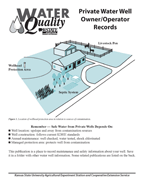Displaying 1 to 15 of 27 Publications
Spanish: Private Wells — Safe Location
MF3667S
Spanish: This publication offers guidelines for recommended separation distance and direction from potential contamination sources when locating a well, which can help protect the quality of private well water. 8 pages, b/w.
Published Date: May 2024
Using Atrazine Wisely
by Sarah Lancaster Peter Tomlinson Ron Graber
MF3714
This publication describes atrazine, a widely used triazine herbicide in Kansas. The publication explains how atrazine should be properly used. 4 pages, color.
Published Date: Aug 2025
Spanish: Water Quality Tests for Private Wells
by James P Murphy et al.
MF3679S
Spanish: This publication helps private water users understand important factors and make critical decisions about the frequency and kind of water tests necessary to provide safe water. 4 pages, b/w.
Published Date: Dec 2024
Spanish: Nitrate and Groundwater, Nitrato y aguas subterráneas
by James P Murphy et al.
MF857S
Spanish: This publication addresses the drinking water nitrate standard, water testing, nitrate sources, the reduction of nitrate contamination risk, and groundwater treatment methods. 4 pages, b/w.
Published Date: Oct 2024
Spanish: Shock Chlorination of Private Water Well Systems
by James P Murphy et al.
MF911S
Spanish: Publication describes shock chlorination process for disinfecting a well and household plumbing system. Four pages, b/w.
Published Date: Nov 2024
Spanish: Testing Private Water Systems
by James P Murphy et al.
MF3655S
Spanish: This publication helps private water users understand important factors and make critical decisions about the frequency and kind of water tests necessary to provide safe water. 4 pages, b/w.
Published Date: Mar 2024
Spanish: Private Well Maintenance and Protection
by James P Murphy et al.
MF3666S
Spanish: Publication describes the maintenance required to keep well water safe. Includes checklist. 4 pages, b/w.
Published Date: Apr 2024
Water Quality Tests for Private Wells
by James P Murphy Stacie Minson Joseph P. Harner III Herschel George Melissa Harvey et al.
MF3679
This publication helps private water users understand important factors and make critical decisions about the frequency and kind of water tests necessary to provide safe water. 4 pages, b/w.
Published Date: Dec 2024
Shock Chlorination for Private Water Well Systems
by James P Murphy Stacie Minson Joseph P. Harner III Herschel George Melissa Harvey et al.
MF911
Publication describes shock chlorination process for disinfecting a well and household plumbing system. 4 pages, b/w.
Revision Date: Nov 2024
Nitrate and Groundwater
by James P Murphy Stacie Minson Joseph P. Harner III Herschel George Melissa Harvey
MF857
This publication addresses the drinking water nitrate standard, water testing, nitrate sources, the reduction of nitrate contamination risk, and groundwater treatment methods. 4 pages, b/w.
Revision Date: Oct 2024
Understanding the Perceptions of Producers Regarding the Ogallala Aquifer Use: A Survey Report
by Matthew Sanderson Amariah Fischer Jonathan Aguilar
SRL144
This survey asked producers in the Ogallala aquifer how they view their role in groundwater use, what they see as consequences of groundwater depletion, and why they believe groundwater should be conserved. Producers were also asked about their worldviews and values. Together, these questions help provide an understanding of the cultural state of the Ogallala aquifer, especially as it pertains to groundwater use. 12 pages, color.
Published Date: Dec 2022
Private Wells — Safe Location
by James P Murphy Stacie Minson Joseph P. Harner III Herschel George Melissa Harvey
MF3667
This publication offers guidelines for recommended separation distance and direction from potential contamination sources when locating a well, which can help protect the quality of private well water. 8 pages, b/w.
Published Date: May 2024
Private Water Well Owner/Operator Records
MF2409A
Document to record information about a water well: well driller, location, maintenance records.Published Date: Jul 2010
Measuring the Depth to Water in Wells
by Danny H. Rogers G. Morgan Powell
MF2669
There are three methods commonly used to measure depth to water in a well. They are: tape measure or weight on a cord, electric sounder and airline tube.Published Date: Jul 2005
Plugging Abandoned Wells
by G. Morgan Powell Danny H. Rogers
MF935
Abandoned wells & test holes are located in fields, farmsteads, etc. without being properly plugged. They are sources for contamination of groundwater & are a physical hazard to animals & children.Revision Date: Jan 1998
Displaying 1 to 15 of 27 Publications
 Sign in
Sign in















